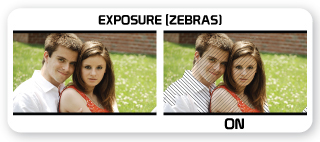The new Nikon D810 is the first DSLR from Nikon that seems like they put in a solid effort to make video recording better. Sure, other cameras along the line have slowly added additional frame rates and resolutions, but the D810’s
new features really show that Nikon was trying to make the experience better for filmmakers. Additionally, Nikon took steps to address the huge file-size problem that kept many still-photographers from considering the D800. Here is a summary of the updated features in the order we’re most excited about:
Zebra Stripes Exposure Indicator

By far the most intriguing feature is the addition of an over-exposure indicator in the form of a zebra stripe overlay of the highlights while in live view. We’ve looked at exposure problems like the inability to change the aperture while in live view (not an issue with the D810, or D800), and while the D800/D810 have the option of pulling up the histogram while recording in live view, the addition of zebra striping will make it even easier to identify hot-spots or exposure problems on the fly and adjust accordingly. We’re often filming in fast-paced, ever-changing light conditions (read: outdoor weddings) where the exposure on someone’s face is often up to mother nature and can swing wildly depending on could cover, trees, etc. This technology has been available on external monitors and electronic viewfinders (like the Zacuto Z-Finder EVF Pro (3.2″)
Nikon D810’s Smaller Raw File Size Option
This site is about video, but lets not kid ourselves – most DSLR videographers do some amount of still photography – and in general, most are shooting raw. However the file sizes are huge – some north of 50mb per picture. Even for someone with a few TBs of storage for hours and hours of HD video (compressed, but still…) – memory cards and hard-drives fill up quickly. That burden left many professional still-shooters (especially high-volume wedding photographers) saying, “forget it – I don’t feel like upgrading all my memory cards and hard drives to make this camera work for me.” The Nikon D810 Raw File size now offers an “S” mode, which is only half the size of the D800’s standard – which will be labeled as “L” (Large) in the D810. While I’d love to get a firmware update for our multiple D800s, I’m not going to hold my breath. Nikon is in the business of selling cameras and that’s not lost in my wishful thinking.
Nikon D810 gets Full HD at 60FPS
I don’t often use 60fps, and it’s not because it’s in 720 on the D800, it’s because I don’t have a use for it in our typical work. That said, I know others who will be excited about finally having a full HD 60fps option. The days of choosing between up-sampling your high frame rate footage or down-sampling your 1080p 24fps footage are over.
Record uncompressed HD with an external device while also recording to the memory card (compressed)
We don’t use external HD recording since most of our clients end up preferring DVDs to BluRays that compressed 1080p is beyond efficient, but for those taking on more serious projects this will allow them to have a backup recording, and also something with a lower resolution that could be helpful in early stages of post-production where file selection can be managed more quickly with smaller files that may not ultimately be used for final production. Getting files a set of files that are easier to work with while simultaneously getting uncompressed HD video will be valuable to some. Even many Cannon cameras struggle with this functionality.
Flat Picture Control
Nikon will also include a flat picture control setting built in, but we’re pretty sure it just saves you from setting up a new color profile manually (which can be done on nearly all Nikon DSLRs). We actually prefer a modified flat picture style, which is discussed in more detail in our article, “Best Nikon Picture Control Settings for Videography“.
Improved Microphone Settings
If you’re recording to the camera as your primary sound (which we don’t recommend), you’ll like the additional settings for the on-board microphone that adds a ‘wide’ setting as well as a ‘voice’ setting that focuses on frequencies in the human voice range. As an aside, we recommend only using on-camera audio as a backup. Even using a line to connect the output from your external recorder to the mic input on the D800/D810 as a backup will be better most of the time than using the on-camera mic.
Time Lapse/Battery Life/Camera Speed/Deeper Grip
Small adjustments, but any improvement in these areas is good for the professional photographer or videographer. Time lapse on the D810 can go up to 9,999 shots and they’ve added a smoothing function to combat timelapse flicker. Whether or not that works as well as a product like LR Timelapse is yet to be seen. Also, the battery life is supposedly improved to allow up to 1,200 shots on a charge (unknown video time), a processor that is 30% faster, and holding the camera should be easier with an improved/deeper grip.
Overall thoughts
The Nikon D810 will be a nice improvement over the D800, and pre-orders for body-only are starting around $3,200 – not too much different from where the D800 was priced for a very long time. Nikon did well on its improvements by focusing on the needs of both still photographers and videographers in the new camera. The only thing we don’t like about the new D810 is it makes the decision on whether or not to upgrade from the D800 difficult. If we needed a new camera body for filming, this would absolutely be our go-to camera.
 Nikon DSLR Video Videography News, Tutorials, Reviews, and Information
Nikon DSLR Video Videography News, Tutorials, Reviews, and Information